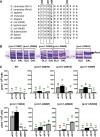Highly mutagenic and severely imbalanced dNTP pools can escape detection by the S-phase checkpoint
- PMID: 20215435
- PMCID: PMC2896522
- DOI: 10.1093/nar/gkq128
Highly mutagenic and severely imbalanced dNTP pools can escape detection by the S-phase checkpoint
Abstract
A balanced supply of deoxyribonucleoside triphosphates (dNTPs) is one of the key prerequisites for faithful genome duplication. Both the overall concentration and the balance among the individual dNTPs (dATP, dTTP, dGTP, and dCTP) are tightly regulated, primarily by the enzyme ribonucleotide reductase (RNR). We asked whether dNTP pool imbalances interfere with cell cycle progression and are detected by the S-phase checkpoint, a genome surveillance mechanism activated in response to DNA damage or replication blocks. By introducing single amino acid substitutions in loop 2 of the allosteric specificity site of Saccharomyces cerevisiae RNR, we obtained a collection of strains with various dNTP pool imbalances. Even mild dNTP pool imbalances were mutagenic, but the mutagenic potential of different dNTP pool imbalances did not directly correlate with their severity. The S-phase checkpoint was activated by the depletion of one or several dNTPs. In contrast, when none of the dNTPs was limiting for DNA replication, even extreme and mutagenic dNTP pool imbalances did not activate the S-phase checkpoint and did not interfere with the cell cycle progression.
Figures




References
-
- Reichard P. Interactions between deoxyribonucleotide and DNA synthesis. Annu. Rev. Biochem. 1988;57:349–374. - PubMed
-
- Kunz BA, Kohalmi SE, Kunkel TA, Mathews CK, McIntosh EM, Reidy JA. International Commission for Protection Against Environmental Mutagens and Carcinogens. Deoxyribonucleoside triphosphate levels: a critical factor in the maintenance of genetic stability. Mutat. Res. 1994;318:1–64. - PubMed
-
- Zegerman P, Diffley JF. DNA replication as a target of the DNA damage checkpoint. DNA Repair. 2009;8:1077–1088. - PubMed
-
- Trudel M, Van Genechten T, Meuth M. Biochemical characterization of the hamster thy mutator gene and its revertants. J. Biol. Chem. 1984;259:2355–2359. - PubMed
-
- Weinberg GL, Ullman B, Wright CM, Martin DW., Jr The effects of exogenous thymidine on endogenous deoxynucleotides and mutagenesis in mammalian cells. Somat. Cell Mol. Genet. 1985;11:413–419. - PubMed
Publication types
MeSH terms
Substances
LinkOut - more resources
Full Text Sources
Other Literature Sources
Molecular Biology Databases

